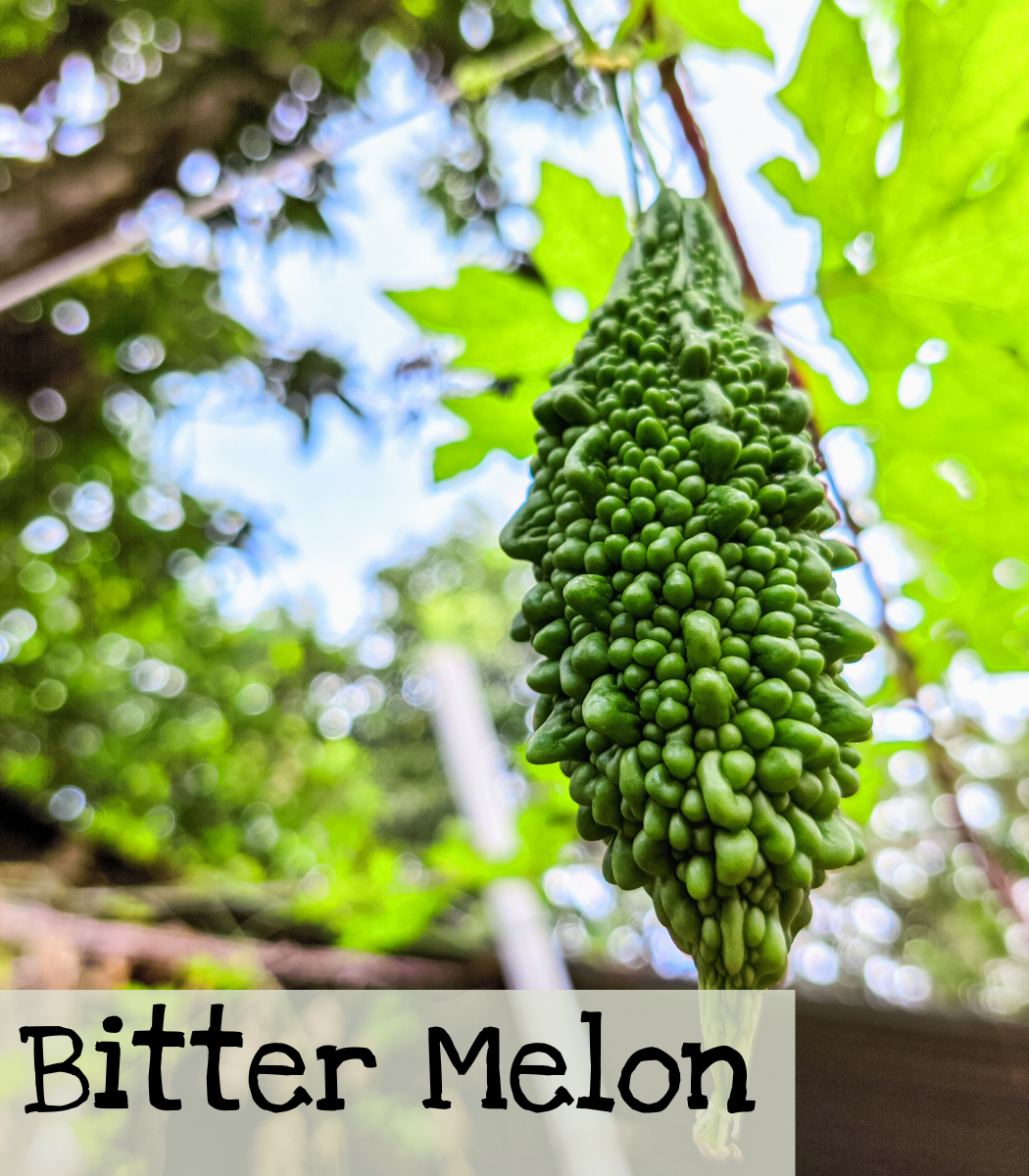
Bitter Melon
Bitter melon is a fast-growing vine that does well on a trellis. Also known as goya, balsam pear, bitter gourd, and karela, it requires little maintenance and thrives in hot, humid weather.
|
Pearl Goya |
|
Momordica charantia |
|
Difficult in GA, Intermediate in zones 9-11 |
|
Difficult |
|
2-3 years if properly stored |
|
Annual |
|
Grow Zones 9-11 |
|
7-21 days |
|
75-95 F |
|
Scarify and soak overnight |
|
3/4 – 1 inch |
|
Vine support |
|
Full Sun |
|
75-80 days |
|
April, May |
|
Yes |

Growing Tips

 (difficult for Jefferson, GA: Zone 8)
(difficult for Jefferson, GA: Zone 8)
When to Start
Spring: Direct sow when soil temperatures have reached an average of 75 F. (Historically, the last week of May and the first week of June for Jefferson, GA.) Find your average soil temperatures.
Start Indoors: Start 4-8 weeks before soil temperatures have consistently reached an 75 F.
How to Grow
As bitter melon is a tropical plant, it grows best in USDA grow zones 9-11. Jefferson, GA, is right on the border of this, and with a quicker-maturing variety, you should be able to grow it in the Jefferson, GA, area. Because it can take a while to mature, you might have better luck starting it indoors and transplanting it once soil temperatures have consistently reached 75 F.
For Jefferson, GA, this means you historically have a 2-week window to plant bitter melon in order for it to have time to produce fruit before it gets too cold for the melon. This is why starting indoors, hardening off, and then transplanting during this 2-week window will most likely give you the best results for zone 8b. Find your grow zone.
To start indoors:
Start at least 4-8 weeks before transplanting. As seeds can be slow to germinate, sometimes taking 21 days, soak them overnight. You can also try nicking them to improve germination. Prepare the seed starting mix by pre-moistening it. Fill the cells or pots with pre-moistened seed starting mix and sow the seeds to a depth of 3/4 to 1 inch deep.
As seeds need a soil temperature of 75-95 F to germinate, a heat mat is needed to keep the soil temperatures consistent.
Bitter melon dislikes cold weather and cold soil. Harden off and transplant ONLY once soil temperatures have consistently reached 75 F, for your area.
Direct Sowing
When direct sowing, wait until the soil temperatures have reached 75 F. Prepare the seeds before sowing, following the steps listed above. Then, sow to a depth of 1 inch in a full sun bed and water the seeds in. Keep the soil moist but not soggy throughout the germination process. Thin or space the plants 24 inches apart.
Care
Bitter melon thrives in heat and humidity and likes sandy or loamy soil best. Plant it in a full sun bed and provide a trellis or fence for the vines which can grow up to 16 feet. When not grown on a trellis the fruit tends to rot.
Mildew can be an issue with bitter melon. Encourage good air circulation with proper plant spacing. This will help the leaves dry after a rain shower. Using a soaker hose or drip irrigation slowly and deeply water to a depth of 20 inches. This is necessary to encourage healthy fruit development.
Like other squash, bitter melon produces both male and female flowers. The male flowers typically will only bloom for one day and then fall off the vine.
Harvest
Harvest when the fruit is 4-8 inches long. The more mature the melons are the less bitter they will be. However, bitterness is also determined by variety, and can even vary on the same plant. Harvest regularly to keep the plant producing. The fruit is very perishable, use or freeze within a couple of days of harvest.
Pest Management
Fruit flies can be an issue for bitter melon as they will ruin the fruit. To protect the fruit from fruit flies, the fruit is often wrapped in newspapers or paper bags with an opening at the bottom.
How to use
To use, cut the melon in half and scoop out the seeds and pith, but don’t peel. It can be pickled or stuffed. Often it is curried and served with meat or in stews. The flavors of salty, sweet, and umami pair very well with bitter melon.
Seed Saving

Isolation Distance
Bitter melon is insect-dependent for pollination. Separate varieties by 1 mile to ensure purity. Or you can hand pollinate before the bees are active and close up the female fruit so no bee can get inside. Then mark that fruit with a colorful twist tie and let it fully mature.
Instructions
Allow fruit to fully mature on the vine. Then let it go a bit longer to over-ripe. This is indicated when it turns yellow and soft.
Cut open the fruit and scoop out the seeds. Wash off the red pulp and seed casing.
Leave the seeds to ferment for 2-4 days in a little bit of water. This helps to break down the pulp, making it easier to remove. (It will be stinky.)
Spread seeds out to dry in a well-ventilated area for a week, or until seeds are hard and dry.
Features
- Native to Okinawa, Japan, this heirloom has snow-white globes are an edible ornamental variety that produces loads of pearlescent round fruit. The flavor is milder than a green bitter melon and even boasts umami flavor notes, making it a top choice for soups.

Bitter melon is a tropical plant that grows best in zones 9-11. Wait until the soil temperatures have consitently reached 75 F.
Sources:
Rareseeds.com
